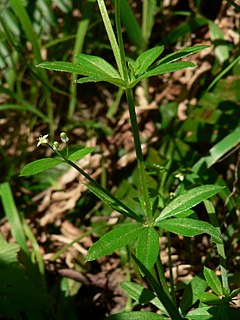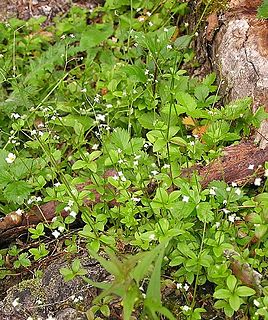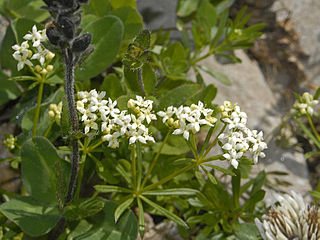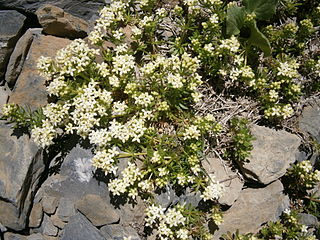
Nikolaus Joseph Freiherr von Jacquin was a scientist who studied medicine, chemistry and botany.

Crataegus laevigata, known as the midland hawthorn, English hawthorn, woodland hawthorn or mayflower, is a species of hawthorn native to western and central Europe, from Great Britain and Spain east to the Czech Republic and Hungary. It is also present in North Africa. The species name is sometimes spelt C. levigata, but the original orthography is C. lævigata.

Galium triflorum is a herbaceous plant of the family Rubiaceae. It is widespread in northern Europe, eastern Asia and North America. The plant is considered a noxious weed in New York, Pennsylvania, Vermont, New Hampshire, Connecticut and Massachusetts.

Galium rotundifolium is a plant species of the Rubiaceae. It is widespread across most of Europe, with the range extending into Morocco, the Caucasus, and southwest Asia from Turkey to Afghanistan. There are also reports of isolated populations in Vietnam, Sabah and Java.

Galium sylvaticum, commonly known as Scotch mist or wood bedstraw, is a plant species of the genus Rubiaceae. Its genus name, Galium, is derived from the Greek word for "milk," apparently because some species have been used to curdle milk.

Dactylorhiza incarnata, the early marsh-orchid, is a perennial, temperate-climate species of orchid generally found growing in wet meadows, and generally on base-rich soils, up to about 2100m asl. The species occurs widely in Europe and Asia from Portugal and Ireland east to Siberia and Xinjiang.

Dactylorhiza traunsteineri is a terrestrial species of orchid native to the cooler parts of the Eastern Hemisphere. It is native to Scandinavia, the Alps, and a region extending from Germany to Western Siberia. Although said by some sources to occur in Britain and Ireland, others say that plants identified as this species are actually Dactylorhiza majalis subsp. traunsteinerioides, a view supported by genetic data.
August von Hayek was an Austrian physician and botanist born in Vienna. He was the son of naturalist Gustav von Hayek and the father of economist Friedrich Hayek (1899–1992).
Pholiurus is a genus of Eurasian plants in the grass family. The only known species is Pholiurus pannonicus, found in a region stretching from Austria to Kazakhstan.

Galium trifidum is a species of flowering plant in the coffee family, known by the common name three-petal bedstraw. It grows widespread in the arctic, temperate and subtropical regions of the Northern Hemisphere: northern and central Asia, northern and eastern Europe and much of North America.

Galium anisophyllon, common name bedstraw or gaillet, is a flowering perennial plant in the family Rubiaceae.
Galium rubioides is a species of plants in the family Rubiaceae, native to Europe and Asia. Natural distribution is from Austria and Croatia east to Russia and Turkey, plus the Caucasus, Western Siberia, Kazakhstan, northern China and the Amur region of Russia. The species is also reportedly naturalized in Northampton County, Pennsylvania.
Galium cometerhizon is a species of plants in the Rubiaceae. It is native to the Pyrenees of Spain and France, and the Island of Corsica in the Mediterranean.

Galium litorale is a rare species of bedstraw in the Rubiaceae family. It is endemic to the island of Sicily in the Mediterranean Sea. In Italian it is known as caglio costiero.

Galium noricum is a species of flowering plant in the family Rubiaceae. It is native to the eastern Alps of Austria, Slovenia, Bavaria and northern Italy. The species is named for the ancient Roman Province of Noricum, which included most of present-day Austria and much of Slovenia.
Galium laevigatum is a species of plants in the Rubiaceae. It is native to the mountains of southern and Central Europe: the Alps, the Pyrenees and the Apennines. It has been recorded from Italy, Switzerland, France, Spain, Portugal, Austria, Slovenia and Croatia.

Galium megalospermum, the Swiss bedstraw or big-seeded bedstraw, is a plant species in the Rubiaceae. It is native to the Alps in Central Europe.

Gagea pusilla is a Eurasian plant species in the lily family. It is native to Italy, Greece, the Balkans, Austria, Hungary, Slovakia, Czech Republic, Ukraine, Belarus, Russia and Kazakhstan.

Crepis pannonica is a European species of flowering plant in the daisy family. It is native to eastern Europe and the Caucasus, as well as being sparingly naturalized in the State of Connecticut in the northeastern United States.

Isopogon spathulatus is a species of flowering plant in the family Proteaceae and is endemic to south-western Western Australia. It is a shrub with linear to egg-shaped leaves with the narrower end towards the base, and more or less spherical heads of hairy pink flowers.















